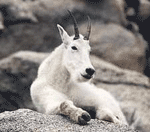 The Mountain Goat or Rocky Mountain goat (Oreamnos americanus) exists only in the Rocky Mountains and the Coast mountains regions in North America. Although it looks like a goat, it is called a goat, it is actually more related to the antelope family. To avoid predators, it can climb rocky cliffs that predators (like the grizzly bear and the cougar) cannot reach. "Mountain goats dig 25-50 mm deep "bedding depressions," where they rest during the mid-day and night. They also dust bathe in these depressions, possibly to remove parasites or shedding skin/hair. These beds have caused damage to certain rare and endangered plant populations in areas of Washington where mountain goats have been introduced. ( source )" About 100,000 mountain goats are estimated to live in North America.
The Mountain Goat or Rocky Mountain goat (Oreamnos americanus) exists only in the Rocky Mountains and the Coast mountains regions in North America. Although it looks like a goat, it is called a goat, it is actually more related to the antelope family. To avoid predators, it can climb rocky cliffs that predators (like the grizzly bear and the cougar) cannot reach. "Mountain goats dig 25-50 mm deep "bedding depressions," where they rest during the mid-day and night. They also dust bathe in these depressions, possibly to remove parasites or shedding skin/hair. These beds have caused damage to certain rare and endangered plant populations in areas of Washington where mountain goats have been introduced. ( source )" About 100,000 mountain goats are estimated to live in North America.
The Mountain goat is listed as Least Concern (LR/lc), lowest risk. Does not qualify for a more at risk category. Widespread and abundant taxa are included in this category, on the IUCN Red List of Threatened Species
Namings for the mountain goat
A young / baby of a mountain goat is called a 'kid'. The females are called 'doe or nannie' and males 'buck or billy'. A mountain goat group is called a 'herd'.Some facts about the
Mountain goat
Adult weight : 90 kg (198 lbs)
Maximum longevity : 21 years
Female maturity :912 days
Male maturity : 912 days
Gestation : 184 days
Weaning : 122 days
Litter size : 1
Litters per year : 1
Interval between litters : 365 days
Weight at birth : 3.2 kg (7.04 lbs)
Basal metabolic rate : 46 W
Body mass : 32 kg (70.4 lbs)

Custom Search